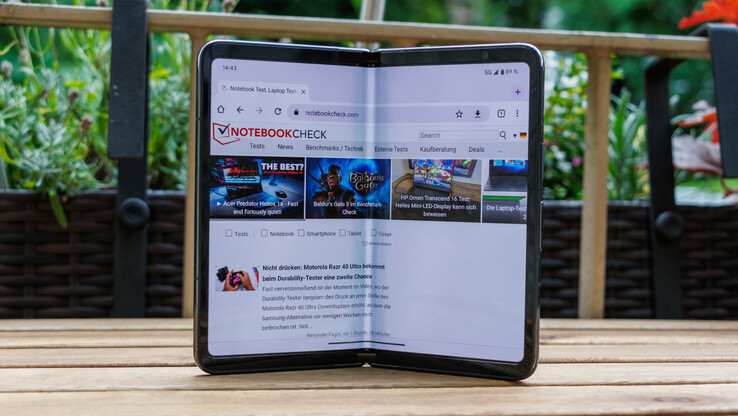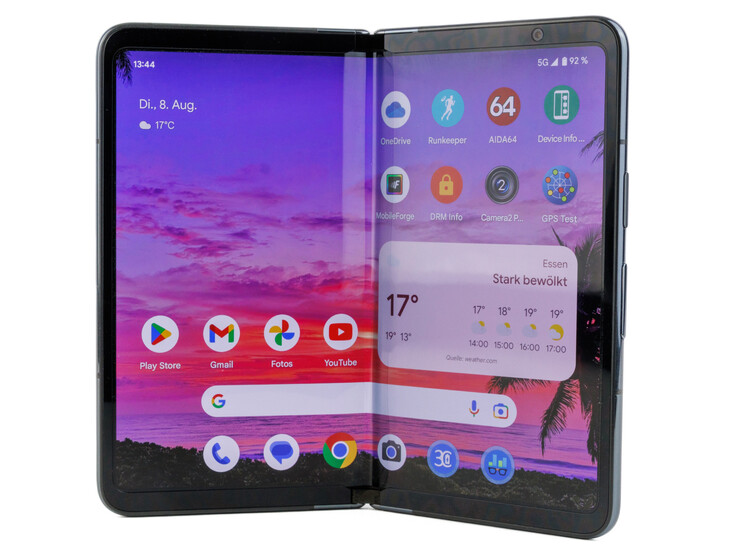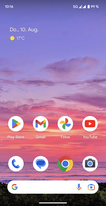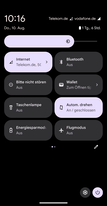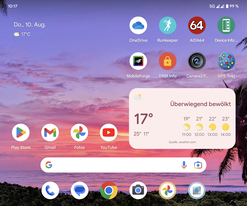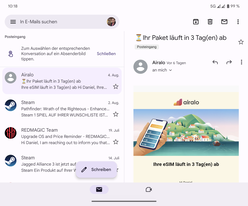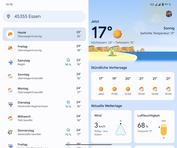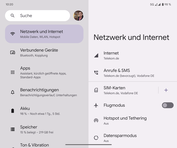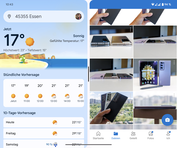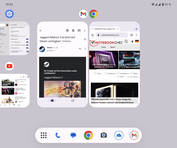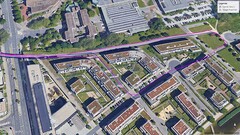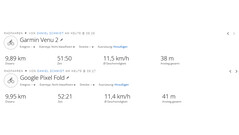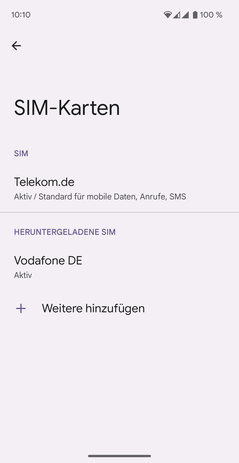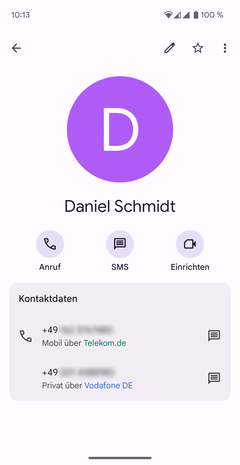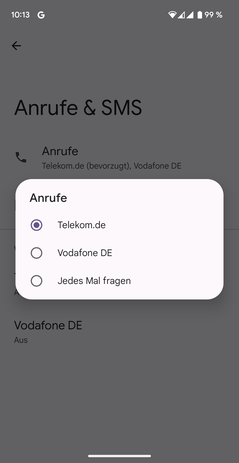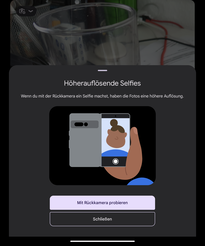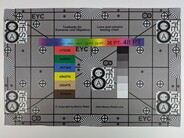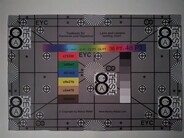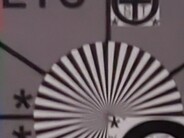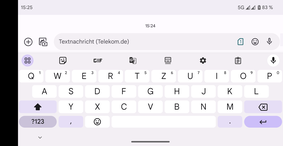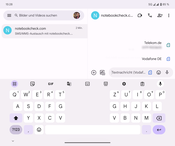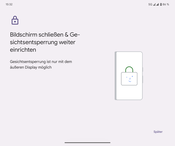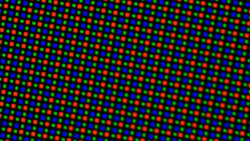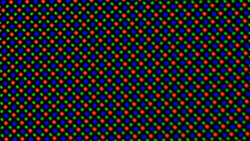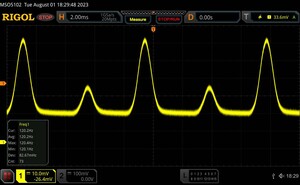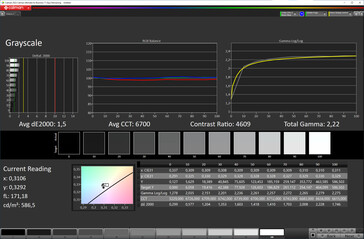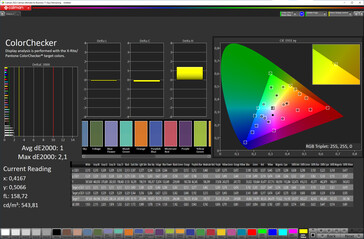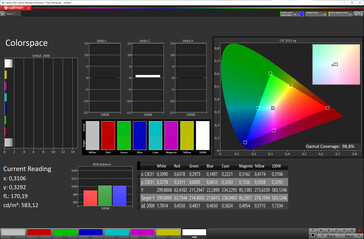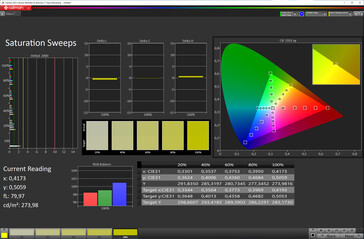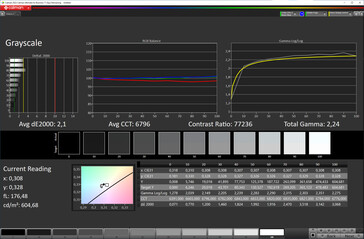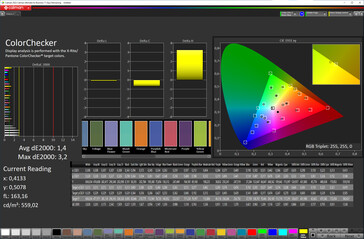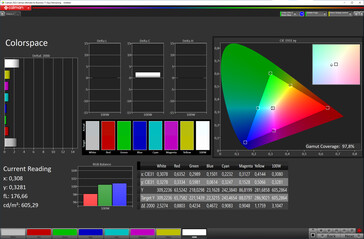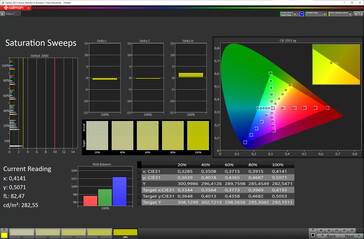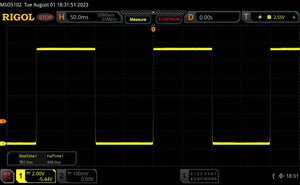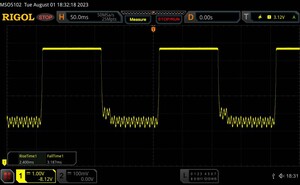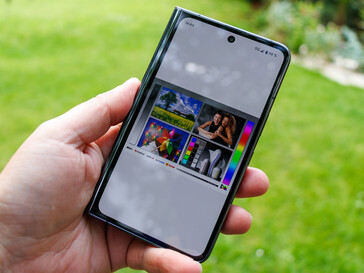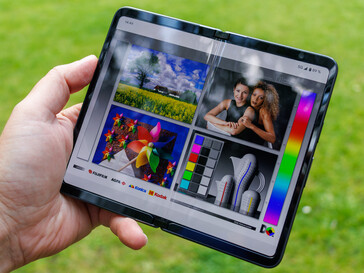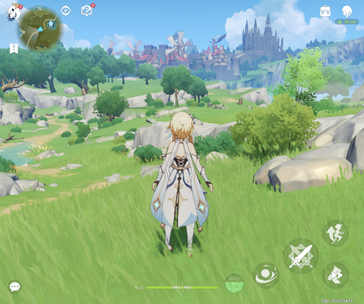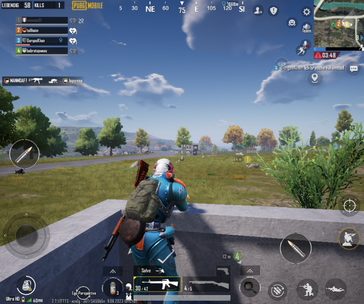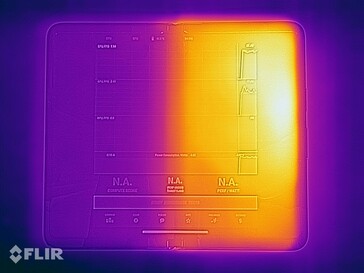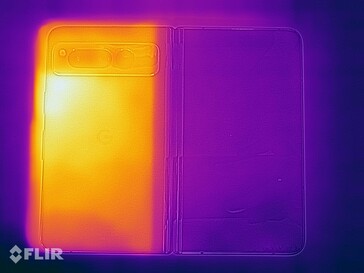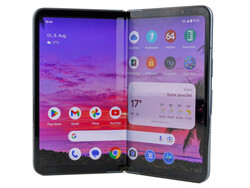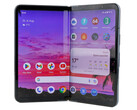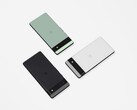Google Pixel Fold review: Foldable smartphone with decent camera
After Google claimed the upper class with the Pixel 7 & Pixel 7 Pro and the middle class with the Pixel 7a, the US giant is venturing into the foldable smartphone field for the first time with its Pixel Fold.
The affiliation to the current Pixel 7 family cannot be overlooked visually, but unlike Samsung, Huawei and Honor the Pixel Fold differs particularly in the form factor, which is more reminiscent of the Oppo Find N2.
Just in time for market launch, Google has also further optimized Android for tablets and foldables, thus greatly benefiting its own products. We take a closer look at the Pixel Fold.
Possible competitors in comparison
Rating | Date | Model | Weight | Drive | Size | Resolution | Price |
|---|---|---|---|---|---|---|---|
| 84.7 % v7 (old) | 08 / 2023 | Google Pixel Fold Tensor G2, Mali-G710 MP7 | 283 g | 256 GB UFS 3.1 Flash | 7.60" | 2208x1840 | |
| 89.1 % v7 (old) | 08 / 2023 | Samsung Galaxy Z Fold5 SD 8 Gen 2 for Galaxy, Adreno 740 | 253 g | 256 GB UFS 4.0 Flash | 7.60" | 2176x1812 | |
| 86.3 % v7 (old) | 06 / 2023 | Huawei Mate X3 SD 8+ Gen 1, Adreno 730 | 239 g | 512 GB UFS 3.1 Flash | 7.85" | 2496x2224 | |
| 87.2 % v7 (old) | 03 / 2023 | Honor Magic Vs SD 8+ Gen 1, Adreno 730 | 261 g | 512 GB UFS 3.1 Flash | 7.90" | 2272x1984 | |
| 86.3 % v7 (old) | 12 / 2022 | Xiaomi Mix Fold 2 SD 8+ Gen 1, Adreno 730 | 262 g | 256 GB UFS 3.1 Flash | 8.02" | 2160x1914 |
Case - Distinctive crease and thick camera
In the comparison field, the Google Pixel Fold is about as thick as a Galaxy Z Fold5 or the Honor Magic Vs and has a thickness of 6.05 millimeters when unfolded; it is 2.5 millimeters more with the camera. When folded, it is 12.1 or 13.6 millimeters thick. It is also quite heavy at 283 grams.
Form factor and workmanship, on the other hand, are convincing. The former in particular is a unique selling point on the European market. The Pixel Fold's gaps are flush and fit perfectly, but it creaks and cracks audibly under light torsional stress. The display-to-surface ratio of 83 percent could also be better. The IPX8 certification, which certifies the Google foldable as waterproof, is a positive aspect.
The stainless steel hinge makes a very solid and high-quality impression, and the foldable display also seems stable, but its seam is very pronounced. This is also due to the fact that the Pixel Fold cannot be fully opened at a 180-degree angle, but stops at about 178 degrees.
The smartphone comes in the colors Obsidian and Porcelain.
Equipment - Pixel Fold comes with USB 3.2 and UWB
The Google Pixel Fold uses a fast USB 3.2 port (Gen. 2), which does not support image output. Unsurprisingly, the device does not have an audio jack or optional memory expansion via microSD.
In return, Google offers two storage variants: the smaller 256 GB model, which is also our test device, priced at US$1799, and the 512 GB variant, priced at US$1919. The latter is also only available in black.
NFC, Bluetooth 5.2 and UWB are on board.
Software - Android with optimized apps for foldables
The Google Pixel Fold comes with Android 13 and is slated to receive security updates for at least five years and three major upgrades, i.e. up to Android 16.
Apps and the system have now been better optimized for use with large displays. In the settings, you can scroll through the menu on the left, while the respective content is displayed on the right. Some apps such as Weather or Gmail have also been optimized accordingly. It is also possible to run two apps side by side and move content between them via drag and drop. While this doesn't apply to many apps, the number will increase in the future.
The security patches on the Pixel Fold were updated during our review (in August) and thus very much up to date.
Communication and GNSS - 5G mmWave, but no Wi-Fi 7
The Google Pixel Fold supports all modern mobile phone standards with an exemplary frequency range. The smartphone even supports mmWave for 5G. Although this is not yet usable in Europe, it definitely makes for a future-proof smartphone. Signal strength was very good during in our tests in the city and gave no cause for criticism. Transmission speeds are also on the expected level.
The Pixel Fold supports the IEEE 802.11 standards i.e. a/b/g/n/ac/ax (Wi-Fi 6E) and can operate in the frequency bands of 2.4, 5.0 and 6.0 GHz. This works flawlessly in tandem with our Asus ROG Rapture GT-AXE11000 reference router because both the transmission rates and the transmission power are solid.
| Networking | |
| Google Pixel Fold | |
| iperf3 receive AXE11000 | |
| iperf3 transmit AXE11000 | |
| iperf3 transmit AXE11000 6GHz | |
| iperf3 receive AXE11000 6GHz | |
| Samsung Galaxy Z Fold5 | |
| iperf3 receive AXE11000 | |
| iperf3 transmit AXE11000 | |
| iperf3 transmit AXE11000 6GHz | |
| iperf3 receive AXE11000 6GHz | |
| Huawei Mate X3 | |
| iperf3 receive AXE11000 | |
| iperf3 transmit AXE11000 | |
| Honor Magic Vs | |
| iperf3 receive AXE11000 | |
| iperf3 transmit AXE11000 | |
| Xiaomi Mix Fold 2 | |
| iperf3 receive AXE11000 | |
| iperf3 transmit AXE11000 | |
| Average of class Smartphone | |
| iperf3 receive AXE11000 | |
| iperf3 transmit AXE11000 | |
| iperf3 transmit AXE11000 6GHz | |
| iperf3 receive AXE11000 6GHz | |
Indoors the Pixel Fold's location is pinpointed quite quickly and accurately. The Foldable supports all global satellite networks in dual-band mode.
On a short bike ride, the Google smartphone has to prove itself against the Garmin Venu 2 fitness smartwatch. The route clearly shows that the Pixel queries its location less frequently and so the Fold's covered distance is correspondingly longer. It shows a visible deviation from the actual route between houses in particular. But no major limitations are to be expected in the way of navigational tasks.
Telephony and Voice Quality
The Google Pixel Fold houses a nano-SIM slot and can use an eSIM, which also enables dual-SIM operation. Users can individually assign a SIM to each stored phone number and optionally choose which number to use before each call. A separate ringtone for the additional SIM cannot be selected. Likewise, the smartphone cannot automatically switch the data connection. Dual SIM users also miss out on the option of installing a messenger app in dual mode. Basic features such as VoLTE and WiFi calling are supported.
The voice quality of the Pixel Fold is very good when held to the ear and reliably filters out most background noise. The foldable also delivers good acoustics in speaker mode and echoes only minimally.
Cameras - Good triple camera in the Google Pixel Fold
The Pixel Fold has two front cameras. One is integrated in the front display, the other in the frame of the foldable panel. Both have a fixed focus. However, the one on the outside can record Ultra HD video at up to 60 FPS, while the one on the inside is limited to Full HD at 30 FPS. Selfies turn out quite good, especially with the optics of the cover display. The bokeh generated in portrait mode is pleasing, but the transitions to the subject are a little rough. Better selfies can be taken with the main camera, where the front panel is used as a viewfinder.
The main sensor of the rear camera works at 48 MPix and uses pixel binning, so that 12 MPix images are created. The pictures convince with a well-balanced color balance and a good white balance. The sharpness is pleasantly pronounced in daylight; only the bokeh of the background looks a bit clumpy and could be a bit softer. Nevertheless, a lot can still be adjusted according to the user's own wishes afterwards. When there is little light, the automatic mode quickly switches to night mode, which brightens up the subject, but also swallows up a few details.
The ultra wide angle delivers average quality. The dynamic range and depth of field are good, but many details are lost and appear uncleanly reproduced. The periscope zoom provides 5x optical magnification and a maximum of 20x magnification digitally. The results here are pleasing, as long as there is sufficient light. None of the lenses offer a dedicated macro mode.
Videos can be recorded with all three lenses in Ultra HD at up to 60 fps. If you reduce the frame rate to 30 FPS, you can also record HDR videos at a color depth of 10 bits.
Image comparison
Choose a scene and navigate within the first image. One click changes the position on touchscreens. One click on the zoomed-in image opens the original in a new window. The first image shows the scaled photograph of the test device.
Main cameraMain cameraUltra wide angle5x zoomLow lightThe Google Pixel Fold does a really good job of capturing our test chart under controlled lighting conditions. Many details are retained, even in the peripheral areas.
The color representation is also convincing and does not reveal any noticeable outliers (DeltaE > 10).
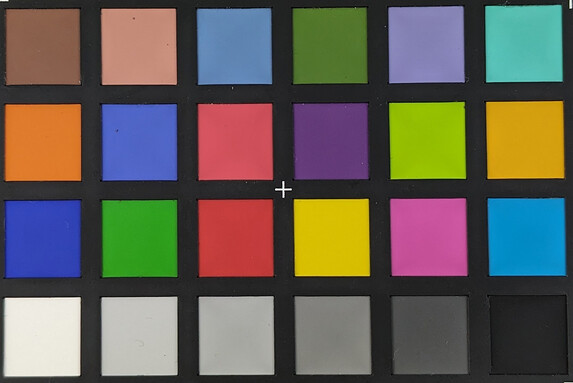
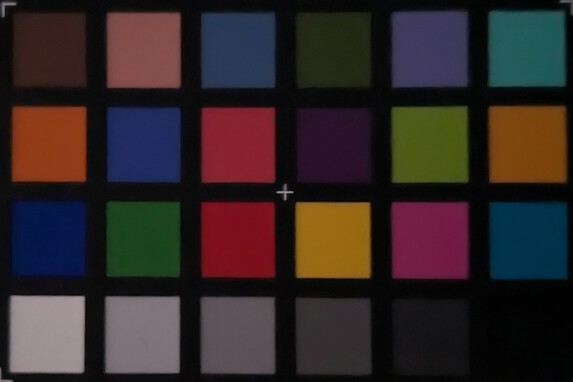
Accessories and Warranty - Foldable comes without power adapter
The Google Pixel Fold has a rather slim scope of delivery: a USB-C cable, a SIM pin and an OTG adapter. That's it. A power adapter is not included, but it can be purchased optionally from Google. Alternatively, third-party power adapters can be used.
Google also offers two optional protective cases. One is made of transparent plastic and the other is available in three colors. Special insurance cannot be purchased. The warranty in Germany is 24 months, which may differ in other regions. Buyers are thus advised to double check before purchasing
Input Devices & Operation - Facial recognition only with front camera
Both capacitive touchscreens have very good gliding properties and implement inputs quickly and accurately. Unfortunately, neither screen offers pen support. The foldable panel also has a very pronounced seam, both optically and haptically.
For biometric security, there is a fingerprint sensor in the power button, which can also be used to launch Google Assistant. This offers good recognition rates and unlocks the foldable smartphone quickly. Facial recognition can also be used for the camera on the external display.
Display - Trendy bright OLEDs with up to 120 Hz in Pixel Fold
On the outside, Google uses a 5.8-inch OLED display with a resolution of 2092x1080 pixels and a refresh rate of up to 120 Hz. The smaller cover display can be much brighter than its foldable counterpart, achieving 1,225 cd/m² in the center of the image in a pure white display with an activated ambient light sensor. The main panel achieves reaches a peak brightness of 1,559 cd/m² with an uniform distribution of bright and dark areas (APL18). If you regulate the brightness manually, you have a maximum of 597 cd/m² at your disposal.
The main display inside measures 7.6 inches and has an aspect ratio of 6:5, a higher resolution of 2,208 x 1,840 and also runs at up to 120 Hz. The brightness is lower and reaches an average of 997 cd/m² with the ambient light sensor activated. It then climbs up to 1318 cd/m² in the APL18 measurement and reaches 608 cd/m² in manual mode. Both displays support the HDR standards HLG, HDR10 and HDR10+.
When measuring the brightness, however, we noticed that the area around the ambient light sensor quickly overheats when exposed to a lot of light and the system then dims the panel heavily. In such a case, we measured only up to 465 cd/m². This certainly might be a problem on hot days.
The typical OLED flickering can also be found on the Pixel Fold's displays and works identically. We measured a fairly constant frequency of 120 Hz with the oscilloscope. Although this is not particularly high, very few people should have any complaints due to the very low modulation level and the even amplitude curve. However, this cannot be ruled out for particularly sensitive individuals.
| |||||||||||||||||||||||||
Brightness Distribution: 98 %
Center on Battery: 1225 cd/m²
Contrast: ∞:1 (Black: 0 cd/m²)
ΔE ColorChecker Calman: 1 | ∀{0.5-29.43 Ø4.78}
ΔE Greyscale Calman: 1.5 | ∀{0.09-98 Ø5}
98.8% sRGB (Calman 2D)
Gamma: 2.22
CCT: 6700 K
| |||||||||||||||||||||||||
Brightness Distribution: 94 %
Center on Battery: 993 cd/m²
Contrast: ∞:1 (Black: 0 cd/m²)
ΔE ColorChecker Calman: 1.4 | ∀{0.5-29.43 Ø4.78}
ΔE Greyscale Calman: 2.1 | ∀{0.09-98 Ø5}
97.8% sRGB (Calman 2D)
Gamma: 2.24
CCT: 6796 K
| Google Pixel Fold OLED, 2208x1840, 7.6" | Samsung Galaxy Z Fold5 Dynamic AMOLED, 2176x1812, 7.6" | Huawei Mate X3 OLED, 2496x2224, 7.9" | Honor Magic Vs OLED, 2272x1984, 7.9" | Xiaomi Mix Fold 2 OLED, 2160x1914, 8" | |
|---|---|---|---|---|---|
| Screen | -28% | 5% | -45% | -6% | |
| Brightness middle (cd/m²) | 993 | 1104 11% | 948 -5% | 803 -19% | 1015 2% |
| Brightness (cd/m²) | 997 | 1107 11% | 969 -3% | 809 -19% | 1022 3% |
| Brightness Distribution (%) | 94 | 97 3% | 94 0% | 97 3% | 98 4% |
| Black Level * (cd/m²) | |||||
| Colorchecker dE 2000 * | 1.4 | 3.1 -121% | 1.4 -0% | 2.27 -62% | 1.6 -14% |
| Colorchecker dE 2000 max. * | 3.2 | 4.2 -31% | 2.6 19% | 5.99 -87% | 3.4 -6% |
| Greyscale dE 2000 * | 2.1 | 3 -43% | 1.7 19% | 3.9 -86% | 2.6 -24% |
| Gamma | 2.24 98% | 2.01 109% | 2.15 102% | 2.25 98% | 2.22 99% |
| CCT | 6796 96% | 6594 99% | 6539 99% | 6234 104% | 6506 100% |
* ... smaller is better
Screen Flickering / PWM (Pulse-Width Modulation)
| Screen flickering / PWM detected | 120.2 Hz | ||
The display backlight flickers at 120.2 Hz (worst case, e.g., utilizing PWM) . The frequency of 120.2 Hz is very low, so the flickering may cause eyestrain and headaches after extended use. In comparison: 53 % of all tested devices do not use PWM to dim the display. If PWM was detected, an average of 8111 (minimum: 5 - maximum: 343500) Hz was measured. | |||
Series of measurements at a fixed zoom level and different brightness settings
Upon testing the display's color and display accuracy with the Calman analysis software, we achieved the best results with the Natural color profile. The external display is even more accurate than the foldable screen: its values are so good that deviations cannot be seen with the naked eye.
If you use the default setting, you'll have a visibly cooler display, but you can also use the larger DCI-P3 color space.
Display Response Times
| ↔ Response Time Black to White | ||
|---|---|---|
| 1.59 ms ... rise ↗ and fall ↘ combined | ↗ 0.7815 ms rise | |
| ↘ 0.808 ms fall | ||
| The screen shows very fast response rates in our tests and should be very well suited for fast-paced gaming. In comparison, all tested devices range from 0.1 (minimum) to 240 (maximum) ms. » 8 % of all devices are better. This means that the measured response time is better than the average of all tested devices (20.2 ms). | ||
| ↔ Response Time 50% Grey to 80% Grey | ||
| 5.59 ms ... rise ↗ and fall ↘ combined | ↗ 2.4 ms rise | |
| ↘ 3.187 ms fall | ||
| The screen shows very fast response rates in our tests and should be very well suited for fast-paced gaming. In comparison, all tested devices range from 0.165 (minimum) to 636 (maximum) ms. » 17 % of all devices are better. This means that the measured response time is better than the average of all tested devices (31.6 ms). | ||
Performance - Tensor G2 with 12 GB RAM
Like the other current smartphones from Google, the Pixel Fold is powered by a Google Tensor G2 and has 12 GB of LPDDR5 RAM in both storage variants.
Although the SoC is positioned in the upper class, it could not keep up with the Snapdragon 8+ Gen 1 last year. The gap to the current Snapdragon 8 Gen 2 has increased accordingly.
In the system benchmarks, however, it is noticeable that the Fold also falls behind its siblings with an identical SoC. This is partly due to the fact that the Pixel Fold has more pixels to process, but also because of the poorer cooling of the SoC, which we'll discuss in more detail in the Temperature section.
| UL Procyon AI Inference for Android - Overall Score NNAPI | |
| Xiaomi Mix Fold 2 | |
| Average Google Tensor G2 (37656 - 44323, n=5) | |
| Google Pixel Fold | |
| Average of class Smartphone (3769 - 81594, n=139, last 2 years) | |
| Honor Magic Vs | |
| Samsung Galaxy Z Fold5 | |
| AImark - Score v3.x | |
| Average of class Smartphone (82 - 307528, n=125, last 2 years) | |
| Xiaomi Mix Fold 2 | |
| Honor Magic Vs | |
| Average Google Tensor G2 (496 - 1008, n=5) | |
| Google Pixel Fold | |
Graphics acceleration is handled by the ARM Mali-G710 MP7 integrated into the SoC. It delivers high performance, but is clearly subordinate to the current Adrenos from Qualcomm. Due to the high resolution of the main display, the onscreen rates are also lower than, for example, those of the Pixel 7 Pro, which means that the frame rate is around 30 percent lower.
GFXBench (DX / GLBenchmark) 2.7: T-Rex Onscreen | 1920x1080 T-Rex Offscreen
GFXBench 3.0: on screen Manhattan Onscreen OGL | 1920x1080 1080p Manhattan Offscreen
GFXBench 3.1: on screen Manhattan ES 3.1 Onscreen | 1920x1080 Manhattan ES 3.1 Offscreen
GFXBench: on screen Car Chase Onscreen | 1920x1080 Car Chase Offscreen | on screen Aztec Ruins High Tier Onscreen | 2560x1440 Aztec Ruins High Tier Offscreen | on screen Aztec Ruins Normal Tier Onscreen | 1920x1080 Aztec Ruins Normal Tier Offscreen | 3840x2160 4K Aztec Ruins High Tier Offscreen
| 3DMark / Wild Life Extreme Unlimited | |
| Samsung Galaxy Z Fold5 | |
| Huawei Mate X3 | |
| Honor Magic Vs | |
| Xiaomi Mix Fold 2 | |
| Google Pixel Fold | |
| 3DMark / Wild Life Extreme | |
| Samsung Galaxy Z Fold5 | |
| Huawei Mate X3 | |
| Honor Magic Vs | |
| Xiaomi Mix Fold 2 | |
| Google Pixel Fold | |
| 3DMark / Wild Life Unlimited Score | |
| Samsung Galaxy Z Fold5 | |
| Huawei Mate X3 | |
| Xiaomi Mix Fold 2 | |
| Honor Magic Vs | |
| Google Pixel Fold | |
| 3DMark / Wild Life Score | |
| Honor Magic Vs | |
| Google Pixel Fold | |
| 3DMark / Sling Shot Extreme (ES 3.1) Unlimited Physics | |
| Huawei Mate X3 | |
| Samsung Galaxy Z Fold5 | |
| Xiaomi Mix Fold 2 | |
| Google Pixel Fold | |
| 3DMark / Sling Shot Extreme (ES 3.1) Unlimited Graphics | |
| Samsung Galaxy Z Fold5 | |
| Huawei Mate X3 | |
| Xiaomi Mix Fold 2 | |
| Google Pixel Fold | |
| 3DMark / Sling Shot Extreme (ES 3.1) Unlimited | |
| Samsung Galaxy Z Fold5 | |
| Huawei Mate X3 | |
| Xiaomi Mix Fold 2 | |
| Google Pixel Fold | |
| GFXBench (DX / GLBenchmark) 2.7 / T-Rex Onscreen | |
| Google Pixel Fold | |
| Samsung Galaxy Z Fold5 | |
| Xiaomi Mix Fold 2 | |
| Huawei Mate X3 | |
| Honor Magic Vs | |
| GFXBench (DX / GLBenchmark) 2.7 / T-Rex Offscreen | |
| Huawei Mate X3 | |
| Honor Magic Vs | |
| Xiaomi Mix Fold 2 | |
| Samsung Galaxy Z Fold5 | |
| Google Pixel Fold | |
| GFXBench 3.0 / Manhattan Onscreen OGL | |
| Xiaomi Mix Fold 2 | |
| Samsung Galaxy Z Fold5 | |
| Huawei Mate X3 | |
| Google Pixel Fold | |
| Honor Magic Vs | |
| GFXBench 3.0 / 1080p Manhattan Offscreen | |
| Honor Magic Vs | |
| Huawei Mate X3 | |
| Xiaomi Mix Fold 2 | |
| Samsung Galaxy Z Fold5 | |
| Google Pixel Fold | |
| GFXBench 3.1 / Manhattan ES 3.1 Onscreen | |
| Xiaomi Mix Fold 2 | |
| Samsung Galaxy Z Fold5 | |
| Huawei Mate X3 | |
| Honor Magic Vs | |
| Google Pixel Fold | |
| GFXBench 3.1 / Manhattan ES 3.1 Offscreen | |
| Honor Magic Vs | |
| Xiaomi Mix Fold 2 | |
| Huawei Mate X3 | |
| Samsung Galaxy Z Fold5 | |
| Google Pixel Fold | |
| GFXBench / Car Chase Onscreen | |
| Honor Magic Vs | |
| Samsung Galaxy Z Fold5 | |
| Xiaomi Mix Fold 2 | |
| Huawei Mate X3 | |
| Google Pixel Fold | |
| GFXBench / Car Chase Offscreen | |
| Huawei Mate X3 | |
| Honor Magic Vs | |
| Xiaomi Mix Fold 2 | |
| Samsung Galaxy Z Fold5 | |
| Google Pixel Fold | |
| GFXBench / Aztec Ruins High Tier Onscreen | |
| Samsung Galaxy Z Fold5 | |
| Honor Magic Vs | |
| Xiaomi Mix Fold 2 | |
| Huawei Mate X3 | |
| Google Pixel Fold | |
| GFXBench / Aztec Ruins High Tier Offscreen | |
| Samsung Galaxy Z Fold5 | |
| Huawei Mate X3 | |
| Honor Magic Vs | |
| Xiaomi Mix Fold 2 | |
| Google Pixel Fold | |
| GFXBench / Aztec Ruins Normal Tier Onscreen | |
| Samsung Galaxy Z Fold5 | |
| Honor Magic Vs | |
| Xiaomi Mix Fold 2 | |
| Huawei Mate X3 | |
| Google Pixel Fold | |
| GFXBench / Aztec Ruins Normal Tier Offscreen | |
| Huawei Mate X3 | |
| Samsung Galaxy Z Fold5 | |
| Honor Magic Vs | |
| Xiaomi Mix Fold 2 | |
| Google Pixel Fold | |
| GFXBench / 4K Aztec Ruins High Tier Offscreen | |
| Samsung Galaxy Z Fold5 | |
| Huawei Mate X3 | |
| Honor Magic Vs | |
| Xiaomi Mix Fold 2 | |
| Google Pixel Fold | |
In matters of web surfing the Google Pixel Fold provides decent performance and also delivers good results in the benchmarks. Also practical is that the websites accessed are displayed directly in the desktop version on the large display.
| Jetstream 2 - 2.0 Total Score | |
| Samsung Galaxy Z Fold5 (Chrome 115) | |
| Average of class Smartphone (23.8 - 387, n=152, last 2 years) | |
| Honor Magic Vs (Chrome 111) | |
| Google Pixel Fold (Chrome 115) | |
| Average Google Tensor G2 (96.3 - 117.8, n=5) | |
| Huawei Mate X3 (Huawei Browser 13.0.4) | |
| Xiaomi Mix Fold 2 (MiUI-Browser 14.7) | |
| Speedometer 2.0 - Result 2.0 | |
| Average of class Smartphone (15.2 - 643, n=126, last 2 years) | |
| Google Pixel Fold (Chrome 115) | |
| Average Google Tensor G2 (100 - 134, n=5) | |
| Honor Magic Vs (Chome 111) | |
| WebXPRT 4 - Overall | |
| Samsung Galaxy Z Fold5 (Chrome 115) | |
| Average of class Smartphone (27 - 306, n=148, last 2 years) | |
| Google Pixel Fold (Chrome 115) | |
| Average Google Tensor G2 (90 - 111, n=5) | |
| Huawei Mate X3 (Huawei Browser 13.0.4) | |
| Honor Magic Vs (Chrome 111) | |
| Xiaomi Mix Fold 2 | |
| Octane V2 - Total Score | |
| Samsung Galaxy Z Fold5 (Chrome 115) | |
| Huawei Mate X3 (Huawei Browser 13.0.4) | |
| Average of class Smartphone (2228 - 121337, n=200, last 2 years) | |
| Average Google Tensor G2 (43817 - 47939, n=5) | |
| Google Pixel Fold (Chrome 115) | |
| Honor Magic Vs (Chrome 111) | |
| Xiaomi Mix Fold 2 (MiUI-Browser 14.7) | |
| Mozilla Kraken 1.1 - Total | |
| Xiaomi Mix Fold 2 (MiUI-Browser 14.7) | |
| Average of class Smartphone (257 - 28190, n=155, last 2 years) | |
| Google Pixel Fold (Chrome 115) | |
| Honor Magic Vs (Chrome 111) | |
| Average Google Tensor G2 (920 - 1075, n=5) | |
| Huawei Mate X3 (Huawei Browser 13.0.4) | |
| Samsung Galaxy Z Fold5 (Chrome 115) | |
* ... smaller is better
The Google Pixel Fold still uses UFS 3.1 storage and not the more modern UFS 4.0, which is simply due to the fact that it is not yet supported by the Tensor G2. Although the smartphones in the comparison field use the older standard, they are all faster. The gap to the Galaxy Z Fold5 or the Magic V2 is much larger, as they use UFS 4.0.
| Google Pixel Fold | Huawei Mate X3 | Honor Magic Vs | Xiaomi Mix Fold 2 | Samsung Galaxy Z Fold4 5G | Average 256 GB UFS 3.1 Flash | Average of class Smartphone | |
|---|---|---|---|---|---|---|---|
| AndroBench 3-5 | 41% | 17% | 53% | 20% | 19% | 42% | |
| Sequential Read 256KB (MB/s) | 1606.37 | 1953.41 22% | 1695.2 6% | 1882.11 17% | 1854.98 15% | 1757 ? 9% | 2222 ? 38% |
| Sequential Write 256KB (MB/s) | 1169.32 | 1479.42 27% | 1296.5 11% | 1783.27 53% | 1251.57 7% | 1204 ? 3% | 1841 ? 57% |
| Random Read 4KB (MB/s) | 219.11 | 261.78 19% | 270.2 23% | 342.67 56% | 321.87 47% | 287 ? 31% | 294 ? 34% |
| Random Write 4KB (MB/s) | 238.72 | 466.74 96% | 300.1 26% | 446.48 87% | 265.9 11% | 318 ? 33% | 334 ? 40% |
Gaming - Pixel Fold lags and stutters
Normal casual games pose no issue for the Google Pixel Fold, but things take a turn in graphically demanding titles that are played on the large display, which we took a closer look at with GameBench.
In PUGB Mobile, the gaming experience is really good thanks to the large panel. The HD setting runs very smoothly at an almost constant 40 FPS, even at the highest detail level. However, fans of Genshin Impact, which is very demanding, will be disappointed because the game occasionally stutters, even at the lowest detail level.
Emissions - Google foldable with weak cooling
Temperature
As expected, the surface temperatures of the Google Pixel Fold are low when idling in maximum display brightness. Under load, they climb to a peak of over 46 °C and the right side of the foldable also heated up considerably during gaming, reaching up to 44 °C in places.
We use the 3DMark stress test to check how well the SoC copes with the generated heat under load. The Pixel Fold loses up to 50 percent of its original performance and is also slower than other Pixel smartphones. For comparison, a Magic Vs also throttles its performance by around 30 percent under load, but is still faster than the Pixel Fold when cold.
(-) The maximum temperature on the upper side is 46.5 °C / 116 F, compared to the average of 35.2 °C / 95 F, ranging from 21.9 to 247 °C for the class Smartphone.
(±) The bottom heats up to a maximum of 44.8 °C / 113 F, compared to the average of 34 °C / 93 F
(+) In idle usage, the average temperature for the upper side is 30.3 °C / 87 F, compared to the device average of 32.9 °C / 91 F.
3DMark Wild Life Stress Test
| 3DMark | |
| Wild Life Stress Test Stability | |
| Honor Magic Vs | |
| Samsung Galaxy Z Fold5 | |
| Google Pixel Fold | |
| Huawei Mate X3 | |
| Wild Life Extreme Stress Test | |
| Xiaomi Mix Fold 2 | |
| Honor Magic Vs | |
| Samsung Galaxy Z Fold5 | |
| Google Pixel Fold | |
| Huawei Mate X3 | |
Speakers
The two speakers of the Google Pixel Fold produce appealing sound with balanced mids and highs. Only the low tones are little thin. The spatial audio, when activated, only changes this a little.
Headphones have to be connected via USB-C, which may require an adapter. Missing from the selection of Bluetooth audio codecs are aptX TWS+ and aptX Adaptive, otherwise the portfolio is very complete and also comes with LC3 and Opus.
Google Pixel Fold audio analysis
(+) | speakers can play relatively loud (82.5 dB)
Bass 100 - 315 Hz
(-) | nearly no bass - on average 21.1% lower than median
(±) | linearity of bass is average (12.7% delta to prev. frequency)
Mids 400 - 2000 Hz
(+) | balanced mids - only 2.7% away from median
(+) | mids are linear (5% delta to prev. frequency)
Highs 2 - 16 kHz
(+) | balanced highs - only 1.9% away from median
(+) | highs are linear (3.6% delta to prev. frequency)
Overall 100 - 16.000 Hz
(+) | overall sound is linear (14.7% difference to median)
Compared to same class
» 2% of all tested devices in this class were better, 2% similar, 96% worse
» The best had a delta of 11%, average was 35%, worst was 134%
Compared to all devices tested
» 18% of all tested devices were better, 4% similar, 77% worse
» The best had a delta of 4%, average was 24%, worst was 134%
Samsung Galaxy Z Fold5 audio analysis
(+) | speakers can play relatively loud (88.4 dB)
Bass 100 - 315 Hz
(-) | nearly no bass - on average 20.2% lower than median
(±) | linearity of bass is average (11.5% delta to prev. frequency)
Mids 400 - 2000 Hz
(±) | higher mids - on average 6.2% higher than median
(+) | mids are linear (5.4% delta to prev. frequency)
Highs 2 - 16 kHz
(±) | higher highs - on average 6.5% higher than median
(+) | highs are linear (4.2% delta to prev. frequency)
Overall 100 - 16.000 Hz
(±) | linearity of overall sound is average (18.3% difference to median)
Compared to same class
» 18% of all tested devices in this class were better, 9% similar, 73% worse
» The best had a delta of 11%, average was 35%, worst was 134%
Compared to all devices tested
» 39% of all tested devices were better, 8% similar, 53% worse
» The best had a delta of 4%, average was 24%, worst was 134%
Battery Life - Wireless charging and PD3 support
Power Consumption
The power consumption of the Google Pixel Fold is inconspicuous and quite frugal for a foldable.
The charging speeds depend heavily on the power supply used and can therefore take a very long time. Since the Google smartphone also supports PowerDelivery 3.0 (PD 3.0), we tried it with a suitable power adapter and it is actually quite quick: a full charge took 92 minutes. The battery was 25 percent after 14 minutes, 50 percent after 31 minutes, 80 percent after 56 minutes and 90 percent after 69 minutes.
Wireless charging is also supported, but the Pixel Fold cannot supply other devices with power wirelessly.
| Off / Standby | |
| Idle | |
| Load |
|
Key:
min: | |
| Google Pixel Fold 4821 mAh | Samsung Galaxy Z Fold5 4400 mAh | Huawei Mate X3 4800 mAh | Honor Magic Vs 5000 mAh | Xiaomi Mix Fold 2 4500 mAh | Average Google Tensor G2 | Average of class Smartphone | |
|---|---|---|---|---|---|---|---|
| Power Consumption | 25% | -62% | -6% | 24% | -1% | 10% | |
| Idle Minimum * (Watt) | 0.86 | 0.55 36% | 0.81 6% | 1.3 -51% | 0.97 -13% | 0.896 ? -4% | 0.848 ? 1% |
| Idle Average * (Watt) | 1.7 | 0.9 47% | 4.26 -151% | 1.7 -0% | 1.37 19% | 1.984 ? -17% | 1.434 ? 16% |
| Idle Maximum * (Watt) | 1.8 | 1 44% | 4.45 -147% | 2 -11% | 1.48 18% | 2.07 ? -15% | 1.618 ? 10% |
| Load Average * (Watt) | 9.1 | 9.58 -5% | 10.11 -11% | 7 23% | 3.98 56% | 6.32 ? 31% | 7.01 ? 23% |
| Load Maximum * (Watt) | 11.06 | 10.74 3% | 11.58 -5% | 10.1 9% | 6.83 38% | 10.8 ? 2% | 11.3 ? -2% |
* ... smaller is better
Power consumption: Geekbench (150 cd/m²)
Power consumption: GFXBench (150 cd/m²)
Battery Life
The battery life of the Google Pixel Fold is quite good in our tests. It lasts almost eleven hours during continuous web browsing with an adjusted display brightness of 150 cd/m² on the large screen with Smooth Display activated and is thus on a similar level as the Galaxy Z Fold4. Only the Magic Vs lasts noticeably longer in the comparison field.
| Google Pixel Fold 4821 mAh | Huawei Mate X3 4800 mAh | Honor Magic Vs 5000 mAh | Xiaomi Mix Fold 2 4500 mAh | Samsung Galaxy Z Fold4 5G 4400 mAh | |
|---|---|---|---|---|---|
| Battery runtime | -28% | 7% | -13% | -1% | |
| Reader / Idle (h) | 26.4 | 23.9 -9% | 21.3 -19% | ||
| H.264 (h) | 16 | 18.2 14% | 19.2 20% | ||
| WiFi v1.3 (h) | 10.9 | 7.9 -28% | 12.6 16% | 9.5 -13% | 11.1 2% |
| Load (h) | 4.3 | 4.5 5% | 4 -7% |
Pros
Cons
Verdict - Solid debut from Google
The Google Pixel Fold stands out from the competition in particular due to its form factor, which proved to be absolutely solid in our tests. The foldable smartphone is also not too thick and closes completely flush, but loses a few points on account of its mediocre display-to-surface ratio.
Google's smartphone doesn't win any trophies in terms of performance either. Occasional stutters occur during normal system operation, but more often in gaming and even competing devices from last year are much better equipped.
Google has managed to create a strong first foldable in the Pixel Fold, but it still reveals one or two weaknesses upon closer inspection.
The good camera is a positive and the Pixel Fold's battery runtimes are also solid. The problem of the ambient light sensor is more serious - if we expose it to bright light, it gets hot and dims the display. This may be a problem for some users, especially in summer.
In terms of price, the Google foldable is on par with the Galaxy Z Fold5. Those who don't place much value on the form factor may find the Fold4 to be an exciting alternative, since its price has fallen greatly. Also much cheaper is the Honor Magic Vs.
Price and Availability
In the US, the Pixel Fold is available in Obsidian at Best Buy for $1,799.
Prices are as of 13.08.2023 and are subject to change.
Google Pixel Fold
- 08/11/2023 v7 (old)
Daniel Schmidt
Transparency
The selection of devices to be reviewed is made by our editorial team. The test sample was provided to the author as a loan by the manufacturer or retailer for the purpose of this review. The lender had no influence on this review, nor did the manufacturer receive a copy of this review before publication. There was no obligation to publish this review. As an independent media company, Notebookcheck is not subjected to the authority of manufacturers, retailers or publishers.
This is how Notebookcheck is testing
Every year, Notebookcheck independently reviews hundreds of laptops and smartphones using standardized procedures to ensure that all results are comparable. We have continuously developed our test methods for around 20 years and set industry standards in the process. In our test labs, high-quality measuring equipment is utilized by experienced technicians and editors. These tests involve a multi-stage validation process. Our complex rating system is based on hundreds of well-founded measurements and benchmarks, which maintains objectivity. Further information on our test methods can be found here.




